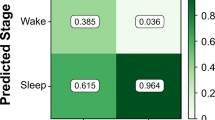Abstract
Here, we propose an automated sleep stage classification method using a wristwatch-type physiological sensing device including a reflective photoelectric volume pulse sensor and a three-axis accelerometer to allow simple and inexpensive assessment of sleep quality. One hundred healthy volunteers (60 males and 40 females, aged 20–60 years old) wore the wristwatch-type physiological sensing device during overnight full polysomnography (PSG). Pulse-to-pulse intervals (PPI) and body movement indexes were determined from the records of the sensing device. The features extracted from the time-domain measures of PPI together with wrist movement indexes were utilized to develop an automated sleep stage classification system. The sleep stages detected by the proposed algorithm were compared with those determined by PSG utilizing the standard performance metrics (accuracy, recall, precision and F-measure). The mean rates of agreement with sleep stages on PSG categorized into two stages (wake and sleep), three stages (wake, non-REM, REM), and four stages (wake, light, and deep non-REM, REM) were 87.3, 74.3, and 68.5%, respectively. The accuracy of sleep stage detection indicated that the proposed method was sufficient for assessing sleep quality in healthy subjects without sleep disorders, and the wristwatch-type sensing device developed here can be used as a portable and easy-to-use home sleep monitoring device.





Similar content being viewed by others
References
Smolensky MH, Di Milia L, Ohayon MM, Philip P. Sleep disorders, medical conditions, and road accident risk. Accid Anal Prev. 2011;43:533–48.
Kucharczyk ER, Morgan K, Hall AP. The occupational impact of sleep quality and insomnia symptoms. Sleep Med Rev. 2012;16:547–59.
Khan MS, Aouad R. The effects of insomnia and sleep loss on cardiovascular disease. Sleep Med Clin. 2017;12:167–77.
Vgontzas AN, Liao D, Bixler EO, Chrousos GP, Vela-Bueno A. Insomnia with objective short sleep duration is associated with a high risk for hypertension. Sleep. 2009;32:491–7.
Grandner MA, Seixas A, Shetty S, Shenoy S. Sleep duration and diabetes risk: population trends and potential mechanisms. Curr Diab Rep. 2016;16:106. https://doi.org/10.1007/s11892-016-0805-8.
Taylor DJ, Mallory LJ, Lichstein KL, Durrence HH, Riedel BW, Bush AJ. Comorbidity of chronic insomnia with medical problems. Sleep. 2007;30:213–8.
Roebuck A, Monasterio V, Gederi E, Osipov M, Behar J, Malhotra A, Penzel T, Clifford GD. A review of signals used in sleep analysis. Physiol Meas. 2014;35:R1–57. https://doi.org/10.1088/0967-3334/35/1/R1.
Schwaibold M, Schochlin J, Bolz A. Automated sleep stage detection with a classical and a neural learning algorithm—methodological aspects. Biomed Tech (Berl). 2002; 47: (Suppl 1 Pt 1):318–20.
Oropesa E, Cycon HL, Jobert M. Sleep stage classification using wavelet transform and neural network. Int Computer Science Inst (ICSI). 1999. http://citeseerx.ist.psu.edu/viewdoc/summary?doi=10.1.1.45.6844.
Langkvist M, Karlsson L, Loutfi A. Sleep stage classification using unsupervised feature learning. Adv Artif Neural Syst. 2012. https://doi.org/10.1155/2012/107046.
Ancoli-Israel S, Cole R, Alessi C, Chambers M, Moorcroft W, Pollak CP. The role of actigraphy in the study of sleep and circadian rhythms. Sleep. 2003;26:342–92.
Paquet J, Kawinska A, Carrier J. Wake detection capacity of actigraphy during Sleep. Sleep. 2007;30:1362–9.
Cole RJ, Kripke DF, Gruen W, Mullaney DJ, Gillin JC. Automatic sleep/wake identification from wrist activity. Sleep. 1992;15:461–9.
Kawamoto K, Kuriyama H, Tajima S. Actigraphic detection of REM sleep based on respiratory rate estimation. J Med Bioeng. 2013;2:20–5.
Schola UJ, Bianchi AM, Cerutti S, Kubicki S. Vegetative background of sleep: spectral analysis of the heart rate variability. Physiol Behav. 1997;62:1037–43.
Mendez MO, Matteucci M, Castronovo V, Ferini-Strambi L, Cerutti S, Bianchi AM. Sleep staging from heart rate variability: time-varying spectral features and hidden markov models. Int J Biomed Eng Technol. 2010;3:246–63.
Iber C, Ancoli-Israel S, Chesson AL, Quan SF. The American academy sleep medicine manual for the scoring of sleep and associated events, rules, terminology and technical specifications. Westchester: American Academy Sleep Medicine; 2007.
Otsu N. A threshold selection method from gray-level histograms. IEEE Trans Syst Man Cybern. 1979;9:62–6.
Redmond SJ, Heneghan C. Cardiorespiratory-based sleep staging in subjects with obstructive sleep apnea. IEEE Trans Biomed Eng. 2006;53:485–96.
Fonseca P, Long X, Radha M, Haakma R, Aarts RM, Rolink J. Sleep stage classification with ECG and respiratory effort. Physiol Meas. 2015;36:2027–40.
De Meersman RE, Stein PK. Vagal modulation and aging. Biol Psychol. 2007;74:165–73.
Itao K, Komazawa M, Katada Y, Itao K, Kobayashi H, Luo ZW. Age-related change of the activity of autonomic nervous system measured by wearable heart rate sensor for long period of time Mind Care 2014: 33–38.
Ohayon MM, Carskadon MA, Guilleminault C, Vitiello MV. Meta-analysis of quantitative sleep parameters from childhood to old age in healthy individuals: developing normative sleep values across the human lifespan. Sleep. 2004;27:1255–73.
Dorffner G, Vitr M, Anderer P. The effects of aging on sleep architecture in healthy subjects. Adv Exp Med Biol. 2015;821:93–100.
Khoo MCK, Chalacheva P. Model-derived markers of autonomic cardiovascular dysfunction in sleep-disordered breathing. Sleep Med Clin. 2016;11:489–501.
Miglis MG. Autonomic dysfunction in primary sleep disorders. Sleep Med. 2016;19:40–9.
Bertisch SM, Muresan C, Schoerning L, Winkelman JW, Taylor JA. Impact of restless legs syndrome on cardiovascular autonomic control. Sleep. 2016;39:565–71.
Acknowledgements
The authors thank Toshiro Momose and the polysomnography technicians for their help and support. We would also like to thank the volunteers who participated in the sleep tests for their effort and enthusiastic cooperation throughout the study.
Funding
This study was supported by collaborative research expenses from Seiko Epson Corporation.
Author information
Authors and Affiliations
Corresponding author
Ethics declarations
Conflict of interest
This study was supported by collaborative research expenses from Seiko Epson Corporation.
Ethical approval
This study was conducted in accordance with International Conference on Harmonization-Good Clinical Practice and the Declaration of Helsinki (2008), and was approved by the Institutional Research Ethics Committee of Shinshu University School of Medicine (no. 2321, no. 2755) and the Human Ethics Committee of Seiko Epson Corporation (no. AHR-2013-005, no. AHR-2014-006).
Informed consent
All subjects were given an adequate explanation of the study and each provided written informed consent.
Rights and permissions
About this article
Cite this article
Fujimoto, K., Ding, Y. & Takahashi, E. Sleep stage detection using a wristwatch-type physiological sensing device. Sleep Biol. Rhythms 16, 449–456 (2018). https://doi.org/10.1007/s41105-018-0175-5
Received:
Accepted:
Published:
Issue Date:
DOI: https://doi.org/10.1007/s41105-018-0175-5




